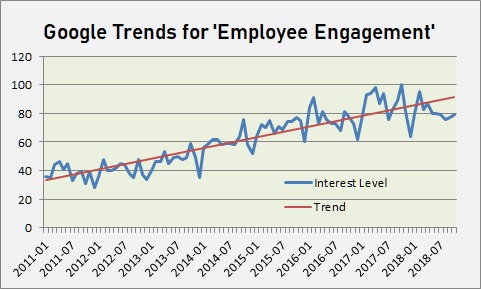Engaged employees fully invest their best selves in the work they do. But what is employee engagement and how is it created?
Employees and leaders intuitively know that when we find a place where we can throw our hearts, spirits, minds, and hands into our work, we are happier, healthier, and produce better results. Yet, most of us struggle to understand exactly why we engage in some environments and don’t in others.
In 2014, we released the book, MAGIC: Five Keys to Unlock the Power of Employee Engagement. When we began our research for the book nearly three years prior, our intent was to answer two questions:
- What is employee engagement?
- What creates employee engagement?
It wasn’t as simple as we thought. Over 14 million employee survey responses from 70 countries later, we finally felt comfortable in answering these two questions.
1. What is employee engagement?
When we conduct workshops on the topic, we often ask the question, “What does a good day look like at work?” Responses vary. Participants may relate a good day to having accomplished something important. Or they may focus on solving a customer issue, making a significant discovery, healing a patient, or rewiring a machine on the assembly line that nobody else could fix.
“Whenever my boss is gone, it’s a good day!” inevitably shows up somewhere in each session. But that’s a separate discussion.
Two important points emerge from these discussions. First, responses rarely relate to perks or compensation. Second, employees intuitively know how engagement feels — and when it’s not present. They get it.
So, what is employee engagement? Here’s how we define it:
Employee engagement is an emotional state where we feel passionate, energetic, and committed to our work. In turn, we fully invest our best selves — our hearts, spirits, minds, and hands — in the work we do.
2. What creates employee engagement?
Apart from anecdotal accounts of increased media coverage, a look at data from Google Trends reveals that engagement is a hot topic. Specifically, searches of the term “employee engagement” increased by 122% during the period from 2011 to 2013 versus the period from 2005 to 2007. Data from 2015 to 2018 shows a continued increase, with the number of searches for related terms growing by nearly 25% each year. The trend line is striking: a steady, dramatic climb in interest around employee engagement.
Understanding the definition of employee engagement now brings up the next question: What creates employee engagement?
Our original 2014 research spelled out five engagement elements that clearly stood out as drivers of employee engagement. We found that the degree to which these elements were present dictated the degree to which engagement occurred in the organization.
We quickly began referring to these elements as the “Five Keys to Unlock the Power of Employee Engagement.” Now, four years later, we have completed phase two of our research, which can be found in our soon-to-be-released book Engagement MAGIC: Five Keys for Engaging Organizations, Leaders, and Individuals. As we doubled our original research to over 30 million employee engagement survey responses, these keys held up time and time again for the hundreds of companies with which we’ve worked and have become the basis for our Engagement MAGIC model.
These five keys are:
- Meaning: Your work has purpose beyond the job itself.
- Autonomy: The power to shape your work and environment in ways that allow you to perform at your best.
- Growth: Being stretched and challenged in ways that result in personal and professional progress.
- Impact: Seeing positive, effective, and worthwhile outcomes and results from your work.
- Connection: The sense of belonging to something beyond yourself.
Yes, line them up and these five keys form the acronym MAGIC, which is a convenient way to keep these keys on the forefront of a leader’s mind. Over and over again, we have watched organizations take steps to focus on these five keys, and watched their team members choose to more completely engage their hearts, spirits, minds, and hands in their work.
Do you want engaged people in your organization? Do you think they would help you become more innovative, competitive, and profitable? Odds are, the answers are yes and yes. Then ensure that your employees find MAGIC in their work. In turn, they fully invest their best selves in the work they do.
That’s the power of employee engagement.
This article originally appeared on the DecisionWise blog.
